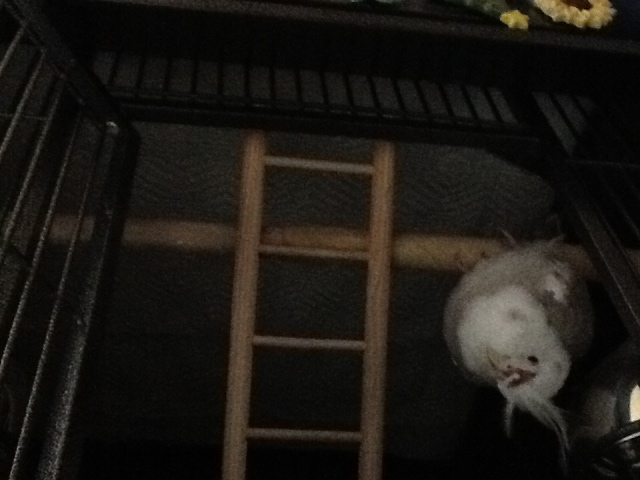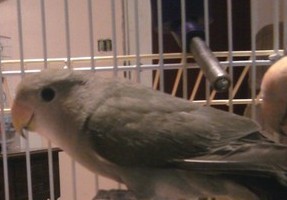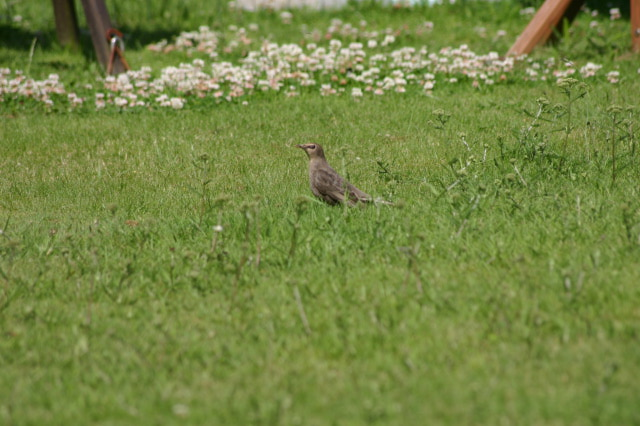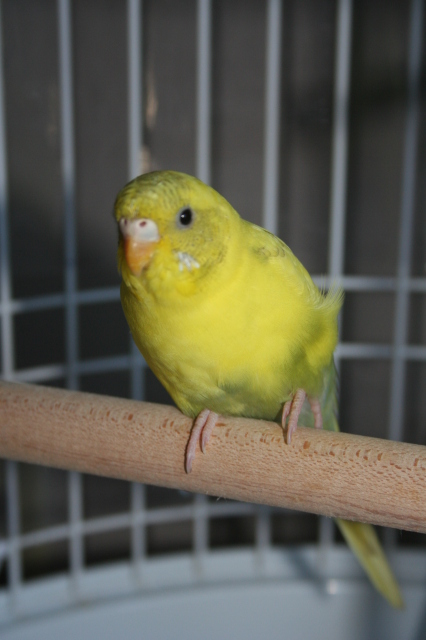QuestionHi, thank you for the answer. It was very helpful. But I have a few more questions. First off, my budgies both bite, hard. They manage to reach around to my fingers any way I hold them, so I use the towel. They absoluteyl refuse to come near my fingers in the cage either.
Also, what can I do to get Schitzo to take food from me. Cuz I cant even reward her, she wont stop moving long enough to even consider a treat. And they do come out often on their own. They run around on the floor with my tiel eatings spilled seeds. But they try to fly away every time I get close. (not my tiel, shes tame). They can't get any altitude, I know how to clip wings. I had a budgie before but he was tame when I got him, even after clipping his wings. So this is completely different. I would like to interact with my budgies as I do with my tiel.
-------------------------
Followup To
Question -
Hi. I have two budgies. One is still young and I got him not too long ago(Tickle). My second is a female who I dont think is all that young(Schitzo). Ive looked at pictures and she is probably over four months while he is probably younger. My problem is neither of these birds have trusted me. Tickle never wants to come out of the cage but I take him out with a towel once or twice a day for 5-10 min sessions. I put him on a stand and feed him millet. Then I get him to step up then right back onto the perch and more millet. I dont let him go back into the cage without me putting him in there on my hand.
Schitzo is more difficult. She doesnt want anything to do with the millet and she still thinks she can fly. She didnt have her wings clipped when I got her so I had to do it myself(I know how and I did a fine job). But she trys to fly off the perch every chance she gets. I just keep putting her back on. Thats what our training sessions are: Me trying to get her to stay on the perch for longer than 2 seconds. Then I put her back in the cage by holding her in a towel and placing her inside.
Am I going about this the right way or should I do it differently? It doesnt seem to be getting anywhere.
Answer -
Hi, Emily. Thanks for posting.
If your budgies were not handfed as babies, they have not imprinted on humans. Therefore, they could be difficult to handle, depending on their life experiences up to this point in time. If you purchased them from a pet shop, they are most likely scared of human fingers and hands (at least) from all the poking, proding, and teasing from visitors to the pet shop. Knowing how old they are and whether they were handfed would be nice to know.
In order to tame these guys, you have to have some knowledge of birds in general and their behaviors, etc. You hit it on the head that these guys don't trust humans. When a bird trusts it's human, you can do just about anything with them. Your goal should be to build up a trusting relationship with your budgies.
You can't build up trust if you're scared of being biten, which I assume is why you are using a towel to bring them out of their cage! I recommend you stop using the towel to work with your budgies...they need to get used to your fingers/hands, not the towel, and it will help your getting more familiar with your birds. When dealing with parrots, you're going to get biten at one point or another! Also, your budgies sense your fear and will react accordingly. Placing your budgie on a bird stand and feeding millet and then back in the cage isn't going to work I'm afraid.
You need to start out with both budgies' wing flight feathers clipped properly. With the correct clipping, your budgies won't be able to gain altitude when they attempt to fly. See my website for links on how to do this (or have it done by an experienced person): http://www.angelfire.com/falcon/birdinfo/index.html
If possible, allow your budgies to come out of their cage(s) on their own. Most parrots don't like their humans intruding in their personal space (i.e., their cage). The cage is their safety zone, their territory, etc., and you should respect this. After all, this is the only place in the world they can call their own. Of course, you have to service the cage and feed them...this is a given.
Your next step should be to take each budgie individually into a neutral room where the parrot cannot see nor get to it's cage and a place with minimal distraction. You must have your budgie's complete focus during training or you should stop the training session and begin again later. Your budgie's attention span could be very short (a couple seconds) to several minutes. The key here is to stop training when you lose the budgie's focus. Place the budgie on the floor, on a bed in the room, on the couch, etc., and simply interact with s/he. In other words, play with the budgie, talk with s/he, try to have s/he step up on your finger/hand, etc., etc. REWARD the budgie with the millet (or other favorite treat) EACH AND EVERY time the budgie responds positively to your commands. NEVER reward negative behavior. Goal here is to build up trust and show the budgie you mean s/he no harm. Placing the bird on a stand and feeding millet is teaching the budgie that when s/he perches on the stand, s/he is rewarded with millet...not much training going on here! You need to take this process a few steps further! It's OK to use the stand for training, but hold off rewarding s/he until s/he actually does something other than just stand on the perch! In other words, reward your budgie(s) with millet when they step up on your hand...this is the positive behavior you want.
Schitzo will try to fly off the perch every chance she gets because this is what birds do. Therefore, get rid of the perch for the time being and interact with your budgie as stated above. At first, your training sessions may only last a couple seconds, but as the bird gets more used to you, the sessions will last longer.
Also, once your budgies settle down a bit (or even if they don't), allow them to sit with you as you watch TV in the evening, allow them to sit with you while you are on the computer, let them come out and sit on top of their cage when you are home doing household chores, etc., etc.
You don't say how long you've owned these budgies, but perhaps they haven't had time to settle down yet in their new environment and get used to you. This is something that must occur first before you can start training/retraining them. Try to find out as much as you can about their background so you know what kind of life they've had up to this point in time. The more you understand your budgies, the easier it will be to work with them.
Come back if you need to. Thanks.
Chrys
AnswerHi, Emily.
Yes, keets do bite hard! You can hold a bird in such a way that it cannot turn it's head around to bite you. Place your thumb and index fingers gently on either side of it's head (just behind the beak but avoiding the eyes), and grasp the bird gently around it's body with your other fingers, and your bird will not be able to bite you when you hold it with your bare hands (this takes some practice). Your budgies are fearful of fingers/hands.
Schitzo won't take food from you until she no longer fears your fingers/hands. And, why should she eat from your hand (which she fears) if she can get what she wants from the floor. In order to get her to start eating from your hand (during training I presume), you need to eliminate other sources of feed/seed (parrots will most ALWAYS choose seed over anything else). Also, with "hyper" budgies, sometimes it helps to get all the extra energy out of them before working with them individually. In other words, before trying to work with one, take the one you want to work with into a neutral room (no cage, no other birds...just you and the bird) and spend several minutes allowing the bird to fly or run around the room to get rid of some of it's energy (with you behind the bird ensuring it doesn't have much time to rest). A budgie will tire easily after a few minutes of constant movement. Once it is depleted of this excess energy, the bird should be tired enough to sit still for a few minutes with you. You must work with each bird individually without the other bird being able to see/hear the other or your training/retraining will not work. With no other food available, when the budgie you are working with does what you ask, reward the bird with a small snippet of spray millet (or other treat). Don't give the budgie a whole millet spray...a few seeds in the palm of your hand is sufficient. The budgie may not take the feed from your hand at first, but should with time as long as other food/seed isn't available at the same time.
Birds like to "follow the leader" so to speak. In other words, since you have a tame tiel, you might use the tiel to your advantage in working with the budgies. For example, if the tiel will eat out of your hand, feed the tiel out of your hand right in front of the budgies and see how long it takes the budgies to do the same. They will be too curious to not do the same as the tiel and, since they probably love spray millet (as I'm sure the tiel does), they won't want the tiel to be the only bird who gets the good stuff! But you have to eliminate other sources of food/seed available at the same time you are training the budgies to eat from you.
Chrys

 White faced cockatiel injury
Question
cockatiel injury
My 8 year old cockatie
White faced cockatiel injury
Question
cockatiel injury
My 8 year old cockatie
 My odd lovebird
Question
Honey
I have a love bird that is approximately
My odd lovebird
Question
Honey
I have a love bird that is approximately
 Identification of a bird
Question
Bird name
Please can you advise what th
Identification of a bird
Question
Bird name
Please can you advise what th
 Eggs! :(
QuestionBroken Egg
QUESTION: I understand lovebi
Eggs! :(
QuestionBroken Egg
QUESTION: I understand lovebi
 Budgie has broken foot?
Question
Maggies foot
Hi there! I got a baby budgie a f
Budgie has broken foot?
Question
Maggies foot
Hi there! I got a baby budgie a f